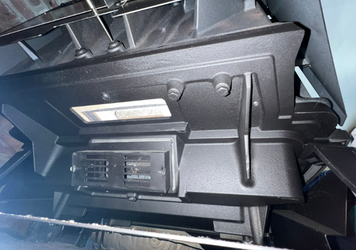Question for those who have the secondary air closed off:
My chimney guy just stopped by for yearly cleaning. He said there was alot more creosote than previous years and highly suggest I dont close off secondary air. Which sucks because before I was getting over firing with the catalyst. Anyone have this issue? Think the creosote is because of secondary air being closed off?
There are alot of experts on here that can give you great advice, and they helped me immensely. However, there is a sense that the VC overall are a more challenging stove with quirks that can't be explained with science. Even the manual suggests operating a wood stove is more of an art. That being said, I think these new VCs have some design quirks. I sat there looking at my stove and where ash accumulates, and just could for the life of me figure out how you would get efficient air flow the way it is design. Of course, Im not an airflow engineer (if such a thing exists). If you saw what my glass looked like after an overnight burn (without the cat which the book doesnt say you must have for an overnight burn), you would be shocked. I then had a stove pipe start crackling and pinging, and smoke puffing out once when I let the fire whoosh up the primary into the stove pipe, after 1/2 of a face cord! Using less than 20% MC wood, (that was meticulously checked and rechecked, then eventually my moisture meter checked against my neighbors much more expensive MM that he offered to give to me)
I have not heard from an expert stove installer, sweep or operator that has one of the modern VC's. Id love to get their opinions after owning one.
When you link the statement together that the chimney guy suggested not to close off secondary, and overfiring the cat, Im not sure what you mean. If you are constantly overfiring the cat then your cat is probably bad. Closing off the primary vs secondary I dont think would reduce the creosote in your stove, if anything I would think it would increase it if you continue to operate it in the manner you are. The book says you can go from very low to very high with this stove BTU wise, but in my experience you have to run a fairly hot fire constantly until you have a great bed of coals then switch over to secondary to get that secondary burn which should be much cleaner regardless if you have the cat installed or not. When I run my stove hot, and am burning on secondary, I see almost NO smoke. I just see heat waves, that's all. yet, I still had my stove pipe burn off creosote that was built up in there from when the stove starts up and then runs too low and just spills out tons of smoke.
Im constantly running outside to look at smoke coming out of chimney. Constantly trying to find that overnight burn sweat spot whereas I wake up to coals vs fine ash and a cold room. Coals, equals black doors and brick - and likely a massive amount of creosote in my chimney. Ash, burning hot and probably got hotter than I like overnight while I wasnt looking (above 650) and then burned down too quickly. The advertised set it and the stove automagically regulates airflow to keep the same temperature is a MASSIVE MASSIVE misrepresentation and IMO false advertising.
Im going to install the cat because I was urged to do so from the folks on here to be able to burn lower temps cleanly. For how often I burn, I thought eh - sure it will burn a bit more dirty but I wouldnt expect to need to sweep for 1-2 cords. Not a fraction of that.


